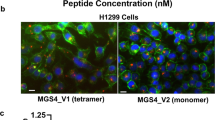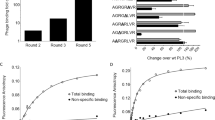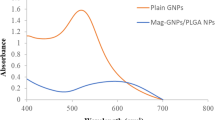Abstract
We have recently described a class of peptides that improve drug delivery by increasing penetration of drugs into solid tumors. These peptides contain a C-terminal C-end Rule (CendR) sequence motif (R/K)XX(R/K), which is responsible for cell internalization and tissue-penetration activity. Tumor-specific CendR peptides contain both a tumor-homing motif and a cryptic CendR motif that is proteolytically unmasked in tumor tissue. A previously described cyclic tumor-homing peptide, LyP-1 (sequence: CGNKRTRGC), contains a CendR element and is capable of tissue penetration. We use here the truncated form of LyP-1, in which the CendR motif is exposed (CGNKRTR; tLyP-1), and show that both LyP-1 and tLyP-1 internalize into cells through the neuropilin-1-dependent CendR internalization pathway. Moreover, we show that neuropilin-2 also binds tLyP-1 and that this binding equally activates the CendR pathway. Fluorescein-labeled tLyP-1 peptide and tLyP-1-conjugated nanoparticles show robust and selective homing to tumors, penetrating from the blood vessels into the tumor parenchyma. The truncated peptide is more potent in this regard than the parent peptide LyP-1. tLyP-1 furthermore improves extravasation of a co-injected nanoparticle into the tumor tissue. These properties make tLyP-1 a promising tool for targeted delivery of therapeutic and diagnostic agents to breast cancers and perhaps other types of tumors.
This is a preview of subscription content, access via your institution
Access options
Subscribe to this journal
Receive 50 print issues and online access
$259.00 per year
only $5.18 per issue
Buy this article
- Purchase on Springer Link
- Instant access to full article PDF
Prices may be subject to local taxes which are calculated during checkout







Similar content being viewed by others
References
Acevedo LM, Barillas S, Weis SM, Gothert JR, Cheresh DA . (2008). Semaphorin 3A suppresses VEGF-mediated angiogenesis yet acts as a vascular permeability factor. Blood 111: 2674–2680.
Agemy L, Friedmann-Morvinski D, Kotamraju VR, Roth L, Sugahara KN, Girard OM et al. (2011). Targeted nanoparticle enhanced proapoptotic peptide as potential therapy for glioblastoma. Proc Natl Acad Sci USA 108: 17450–17455.
Agemy L, Sugahara KN, Kotamraju VR, Gujraty K, Girard OM, Kono Y et al. (2010). Nanoparticle-induced vascular blockade in human prostate cancer. Blood 116: 2847–2856.
Bagri A, Tessier-Lavigne M, Watts RJ . (2009). Neuropilins in tumor biology. Clin Cancer Res 15: 1860–1864.
Becker PM, Waltenberger J, Yachechko R, Mirzapoiazova T, Sham JS, Lee CG et al. (2005). Neuropilin-1 regulates vascular endothelial growth factor-mediated endothelial permeability. Circ Res 96: 1257–1265.
Caunt M, Mak J, Liang WC, Stawicki S, Pan Q, Tong RK et al. (2008). Blocking neuropilin-2 function inhibits tumor cell metastasis. Cancer Cell 13: 331–342.
Chen H, Chedotal A, He Z, Goodman CS, Tessier-Lavigne M . (1997). Neuropilin-2, a novel member of the neuropilin family, is a high affinity receptor for the semaphorins Sema E and Sema IV but not Sema III. Neuron 19: 547–559.
Dallas NA, Gray MJ, Xia L, Fan F, van Buren 2nd G, Gaur P et al. (2008). Neuropilin-2-mediated tumor growth and angiogenesis in pancreatic adenocarcinoma. Clin Cancer Res 14: 8052–8060.
Ellis LM . (2006). The role of neuropilins in cancer. Mol Cancer Ther 5: 1099–1107.
Fogal V, Zhang L, Krajewski S, Ruoslahti E . (2008). Mitochondrial/cell-surface protein p32/gC1qR as a molecular target in tumor cells and tumor stroma. Cancer Res 68: 7210–7218.
Gluzman-Poltorak Z, Cohen T, Herzog Y, Neufeld G . (2000). Neuropilin-2 is a receptor for the vascular endothelial growth factor (VEGF) forms VEGF-145 and VEGF-165 [corrected]. J Biol Chem 275: 18040–18045.
Greish K . (2007). Enhanced permeability and retention of macromolecular drugs in solid tumors: a royal gate for targeted anticancer nanomedicines. J Drug Target 15: 457–464.
Guttmann-Raviv N, Kessler O, Shraga-Heled N, Lange T, Herzog Y, Neufeld G . (2006). The neuropilins and their role in tumorigenesis and tumor progression. Cancer Lett 231: 1–11.
Hamzah J, Kotamraju VR, Seo JW, Agemy L, Fogal V, Mahakian LM et al. (2011). Specific penetration and accumulation of a homing peptide within atherosclerotic plaques of apolipoprotein E-deficient mice. Proc Natl Acad Sci USA 108: 7154–7159.
Haspel N, Zanuy D, Nussinov R, Teesalu T, Ruoslahti E, Aleman C . (2011). Binding of a C-end rule peptide to the neuropilin-1 receptor: a molecular modeling approach. Biochemistry 50: 1755–1762.
He Z, Tessier-Lavigne M . (1997). Neuropilin is a receptor for the axonal chemorepellent Semaphorin III. Cell 90: 739–751.
Heldin CH, Rubin K, Pietras K, Ostman A . (2004). High interstitial fluid pressure -- an obstacle in cancer therapy. Nat Rev Cancer 4: 806–813.
Hoffman JA, Giraudo E, Singh M, Zhang L, Inoue M, Porkka K et al. (2003). Progressive vascular changes in a transgenic mouse model of squamous cell carcinoma. Cancer Cell 4: 383–391.
Hynes RO . (2002). Integrins: bidirectional, allosteric signaling machines. Cell 110: 673–687.
Jain RK . (1999). Transport of molecules, particles, and cells in solid tumors. Annu Rev Biomed Eng 1: 241–263.
Karmali PP, Kotamraju VR, Kastantin M, Black M, Missirlis D, Tirrell M et al. (2009). Targeting of albumin-embedded paclitaxel nanoparticles to tumors. Nanomedicine 5: 73–82.
Kolodkin AL, Levengood DV, Rowe EG, Tai YT, Giger RJ, Ginty DD . (1997). Neuropilin is a semaphorin III receptor. Cell 90: 753–762.
Laakkonen P, Akerman ME, Biliran H, Yang M, Ferrer F, Karpanen T et al. (2004). Antitumor activity of a homing peptide that targets tumor lymphatics and tumor cells. Proc Natl Acad Sci USA 101: 9381–9386.
Laakkonen P, Porkka K, Hoffman JA, Ruoslahti E . (2002). A tumor-homing peptide with a targeting specificity related to lymphatic vessels. Nat Med 8: 751–755.
Liang WC, Dennis MS, Stawicki S, Chanthery Y, Pan Q, Chen Y et al. (2007). Function blocking antibodies to neuropilin-1 generated from a designed human synthetic antibody phage library. J Mol Biol 366: 815–829.
Mamluk R, Klagsbrun M, Detmar M, Bielenberg DR . (2005). Soluble neuropilin targeted to the skin inhibits vascular permeability. Angiogenesis 8: 217–227.
Pan Q, Chanthery Y, Liang WC, Stawicki S, Mak J, Rathore N et al. (2007). Blocking neuropilin-1 function has an additive effect with anti-VEGF to inhibit tumor growth. Cancer Cell 11: 53–67.
Park JH, von Maltzahn G, Zhang L, Derfus AM, Simberg D, Harris TJ et al. (2009). Systematic surface engineering of magnetic nanoworms for in vivo tumor targeting. Small 5: 694–700.
Ruoslahti E . (2002a). Specialization of tumour vasculature. Nat Rev Cancer 2: 83–90.
Ruoslahti E . (2002b). Drug targeting to specific vascular sites. Drug Discov Today 7: 1138–1143.
Ruoslahti E, Bhatia SN, Sailor MJ . (2010). Targeting of drugs and nanoparticles to tumors. J Cell Biol 188: 759–768.
Soker S, Takashima S, Miao HQ, Neufeld G, Klagsbrun M . (1998). Neuropilin-1 is expressed by endothelial and tumor cells as an isoform-specific receptor for vascular endothelial growth factor. Cell 92: 735–745.
Sugahara KN, Teesalu T, Karmali PP, Kotamraju VR, Agemy L, Girard OM et al. (2009). Tissue-penetrating delivery of compounds and nanoparticles into tumors. Cancer Cell 16: 510–520.
Sugahara KN, Teesalu T, Karmali PP, Kotamraju VR, Agemy L, Greenwald DR et al. (2010). Coadministration of a tumor-penetrating peptide enhances the efficacy of cancer drugs. Science 328: 1031–1035.
Takagi S, Tsuji T, Amagai T, Takamatsu T, Fujisawa H . (1987). Specific cell surface labels in the visual centers of Xenopus laevis tadpole identified using monoclonal antibodies. Dev Biol 122: 90–100.
Teesalu T, Sugahara KN, Kotamraju VR, Ruoslahti E . (2009). C-end rule peptides mediate neuropilin-1-dependent cell, vascular, and tissue penetration. Proc Natl Acad Sci USA 106: 16157–16162.
Thorek DL, Chen AK, Czupryna J, Tsourkas A . (2006). Superparamagnetic iron oxide nanoparticle probes for molecular imaging. Ann Biomed Eng 34: 23–38.
Uchida M, Kosuge H, Terashima M, Willits DA, Liepold LO, Young MJ et al. (2011). Protein cage nanoparticles bearing the LyP-1 peptide for enhanced imaging of macrophage-rich vascular lesions. ACS Nano 5: 2493–2502.
von Maltzahn G, Ren Y, Park JH, Min DH, Kotamraju VR, Jayakumar J et al. (2008). In vivo tumor cell targeting with ‘click’ nanoparticles. Bioconjug Chem 19: 1570–1578.
Acknowledgements
We thank Dr Eva Engvall for comments on the manuscript. This work was supported by grant number W81XWH-09-1-0698 and W81XWH-08-1-0727 from the USAMRAA for the Department of Defense (ER). LR was supported by Susan G Komen for the Cure post-doctoral fellowship (KG091411) and GB by a fellowship from the Santa Barbara Cancer Center. ER was supported in part by CA30199 the Cancer Center Support Grant from the NCI.
Author contributions: ER and LR designed the research; LR, LA, TT, KNS and JH performed the research; LA, GB and VRK contributed reagents; LR and ER analyzed the data and wrote the paper. All authors discussed the results and commented on the manuscript.
Author information
Authors and Affiliations
Corresponding author
Ethics declarations
Competing interests
The authors declare no conflict of interest.
Additional information
Supplementary Information accompanies the paper on the Oncogene website
Rights and permissions
About this article
Cite this article
Roth, L., Agemy, L., Kotamraju, V. et al. Transtumoral targeting enabled by a novel neuropilin-binding peptide. Oncogene 31, 3754–3763 (2012). https://doi.org/10.1038/onc.2011.537
Received:
Revised:
Accepted:
Published:
Issue Date:
DOI: https://doi.org/10.1038/onc.2011.537
Keywords
This article is cited by
-
Preclinical evaluation of 68 Ga-labeled peptide CK2 for PET imaging of NRP-1 expression in vivo
European Journal of Nuclear Medicine and Molecular Imaging (2024)
-
Nucleic acid drug vectors for diagnosis and treatment of brain diseases
Signal Transduction and Targeted Therapy (2023)
-
Engineered exosomes from different sources for cancer-targeted therapy
Signal Transduction and Targeted Therapy (2023)
-
Novel sights on therapeutic, prognostic, and diagnostics aspects of non-coding RNAs in glioblastoma multiforme
Metabolic Brain Disease (2023)
-
Emerging role of exosomes in cancer progression and tumor microenvironment remodeling
Journal of Hematology & Oncology (2022)



